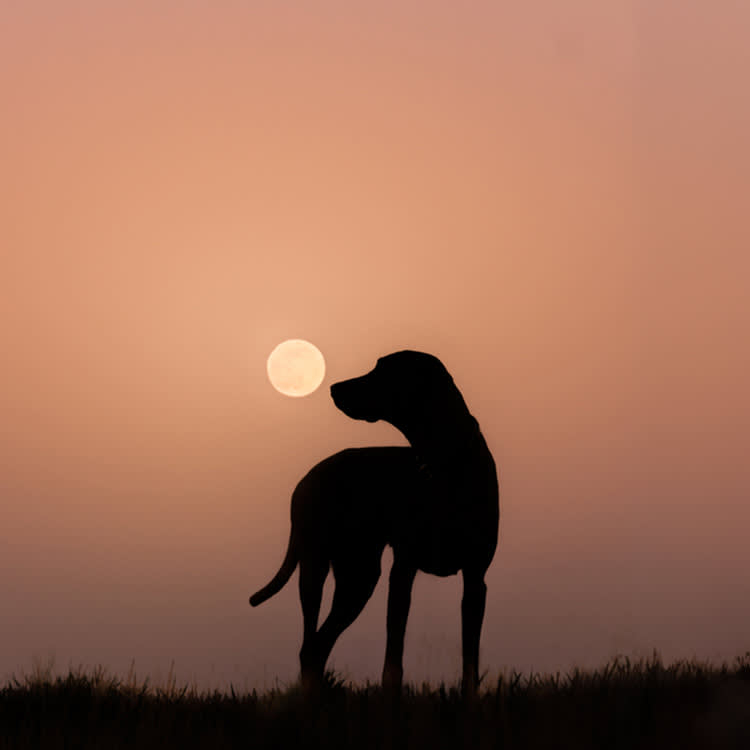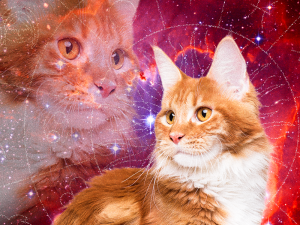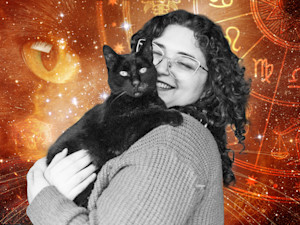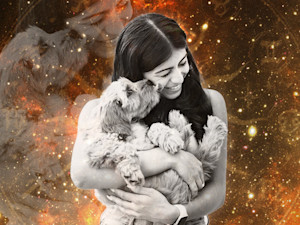How Will This Weekend’s Full “Cold Moon” Affect Our Pets?
Dogs are 28 percent more likely to have a trip to the emergency room around the full moon.

Share Article
We’ve all heard about wolves howling at a full moon, but when I take my dogs out for walks at night, it kind of feels like a myth. Instead of looking at the sky, their eyes are fixed on the ground, where they might find a scrap of stale discarded food. Have these domesticated creatures strayed too far from their lupine ancestors to remember their natural instincts, or did someone just make it all up?
The jury’s still out on that specific call of the wild, but we do know that moon phasesopens in a new tab affect pets in peculiar ways. Studies have shown that dogs and cats are more active during certain lunar activities than others, and emergency room visits spike during certain cyclical periods as well.

Save on the litter with color-changing tech that helps you better care for your cat.
The final full moon of the year is this Sunday, Dec. 15; it will be what’s known as a “cold moon,” which meansopens in a new tab it will rise and set at the most extreme northerly points on the horizon. This only happensopens in a new tab every 18.6 years. If you suspect your pet might be brushing up on their astronomy and acting accordingly this weekend, here’s everything you need to know.
What are the moon phases?
Moon phases denote the various shapes the moon takes on when seen from Earth. The moon does not create its own light; instead, the glowing orb we see at night comes courtesy of the sun, which illuminates the moon from afar. The moon orbits Earth, which orbits the sun. The constantly shifting alignment between these three bodies means that we see the moon from different perspectives each day.
A full-moon cycle takes about four weeks to complete and includes eight phasesopens in a new tab: new moon, waxing crescent, first quarter, waxing gibbous, full moon, waning gibbous, third quarter (also known as “last quarter”), and waning crescent.
For our purposes, the most important of these are the new moon and the full moon. As its name suggests, the new moon marks the start of the lunar cycle. It occurs when the illuminated half of the moon faces away from Earth, making it invisible in the night sky. The full moon, when the illuminated half of the moon is completely visible, occurs halfway through the lunar cycle.
How do pets react to a full moon?
Anecdotally, many pet parents suspect that their critters become a little wilder during the full moon. But does this theory actually hold water?
The full-moon shift is the stuff of legend for both human doctors and veterinarians. “There is a long-standing belief among emergency room personnel (human and veterinary) that ‘crazy things happen’ on a full-moon shift,” says Raegan Wells, emergency and critical care specialist. That’s why, back in 2007, she and fellow researchers at Colorado State University chose to study ER dataopens in a new tab from 1992 to 2002 to see if the statistics added up.
Wells and her team compiled the 10 years’ worth of data — nearly 12,000 case histories of dogs and cats treated at the university’s veterinary medical center — and found that cats were 23 percent more likely to incur emergencies during full-moon days. Dogs, meanwhile, were 28 percent more likely. The emergency events studied included cardiac arrest, epileptic seizuresopens in a new tab, and trauma.
To be clear, these findings do not indicate that ER caseloads were higher on the night of the full moon. “What we found is that when we group the nights heading up to, including, and following a full moon, and compared those to the other days in the lunar cycle that there was a higher volume of cases,” says Wells. The spike in ER visits was starkest during the moon’s three fullest stages — waxing gibbous, full, and waning gibbous.
Why are dogs more likely to get a full-moon-adjacent injury than cats?
As for why dogs outpace cats in this study, Wells offers a couple theories: Most emergency rooms treat more dog patients than cats. Plus, cats are more likely to live outdoorsopens in a new tab — which could mean that if they get sick or injured during a full-moon night, their parents wouldn’t know or seek treatment immediately.
While the study’s observed risk increase of injury around the time of a full moon seem high, Wells also notes that the raw-number increases were relatively low because of the limited number of animals treated at the clinic on any given day. On fuller moon nights, the numbers went up by about one cat or dog. Because of that, she says, “It would be necessary to repeat this study in a higher volume setting to see if the results are reproducible.”
If a larger experiment yields similar findings, Wells says, “it may provide worthy evidence to consider increasing resources in animal emergency rooms on fuller-moon nights.”
While we’re at it, how does the new moon affect pets?
While things seem extra spooky with pets on a full moon, there is also some connection to pet behavior on a new moon. In human astrology, the new moon is a time to take a step back, meditate, and focus our intentions. That said, there’s reason to believe that our furry kinfolk have a different set of priorities.
In 2023, a study publishedopens in a new tab in the international research journal Applied Animal Behaviour Science found that free-range domestic cats (aka, cats who live outdoors) displayed more nocturnal activity around the new moon — which mimics the behavior patterns of their wild brethren, according to co-author Dr. Janko Skok, a professor at the Department of Animal Science at the University of Maribor in Slovenia.
The research team behind the 2023 study observed the cats’ activity as it related to three different natural patterns: the lunar cycle, seasonal cycle, and the circadian cycle (meaning, their behavior across a 24-hour day). Of these three categories, Skok notes, “the lunar cycle was of particular interest to us because there were (surprisingly) no studies on the activity of domestic cats in relation to the lunar cycle, only on their wild counterpart, the wild cat.”
As for why domestic cats turned out to be more active during darker nights, especially the new moon, Skok says that predators in the animal kingdom often copy the activity patterns of their prey — and cats’ primary prey, rodents, are also mainly active during low light.
New moon nights are the darkest in the lunar cycle. Because of this, Skok says, “The higher activity around the new moon could be related to cats having one of the most sophisticated night vision abilities, which increases their hunting success.”
So, should you keep an eye on your pet during the full moon?
As for whether you will notice your cat or dog exhibiting more frisky behavior during a full moon (this weekend or in the future), eh. Maybe. It might just be that you notice more about your surroundings during a full moon. Per Wells, your pet could be acting wacky on other nights, too, but you just perceive them more, because you are looking out for anything weird to happen.
“What I think we are safe to say is that people notice animal activity more on fuller moon nights,” she says. “The jury is still out, in my opinion, as to whether this is driven by the full moon or if we remember things more vividly on full-moon nights.”
References
NASA. “Moon Phases - NASA Science.” Science.nasa.gov, 2024, science.nasa.gov/moon/moon-phases/opens in a new tab.
Neva Merčnik, et al. “Chronobiology of free-ranging domestic cats: Circadian, lunar and seasonal activity rhythms in a wildlife corridor.” Applied Animal Behaviour Science, Volume 269, 2023. https://doi.org/10.1016/j.applanim.2023.106094opens in a new tab
Rice, Doyle. “December 2024 Full Moon: This Weekend’s “Cold” Moon Will Feature a Lunar Rarity.” USA TODAY, 10 Dec. 2024, www.usatoday.com/story/news/nation/2024/12/10/december-2024-full-moon-cold/76861822007/opens in a new tab. Accessed 12 Dec. 2024.
“The next Full Moon Is the Cold Moon - NASA Science.” Nasa.gov, 9 Dec. 2024, science.nasa.gov/solar-system/skywatching/the-next-full-moon-is-the-cold-moon-frost-moon-or-winter-moon/opens in a new tab. Accessed 12 Dec. 2024.
Wells, Raegan J., et al. “Canine and Feline Emergency Room Visits and the Lunar Cycle: 11,940 Cases (1992–2002).” Journal of the American Veterinary Medical Association, vol. 231, no. 2, July 2007, pp. 251–253, https://doi.org/10.2460/javma.231.2.251opens in a new tab. Accessed 19 Nov. 2021.

Laura Bradley
Laura is a New York-based experienced writer and mom of two rescue pups. When she is not writing or walking the pooches, you will probably find her in the community garden.
Related articles
![an orange cat with a purple-and-red night sky in the background]() opens in a new tab
opens in a new tabThe Perfect Cat for Every Astrological Sign
Are you a good match for an extroverted, social kitty — or a little Miss Independent?
![Woman holding her cat.]() opens in a new tab
opens in a new tabAre You and Your Cat Astrologically Compatible?
They might not care about the answer, but you do.
![]() opens in a new tab
opens in a new tabAre You and Your Dog Astrologically Compatible?
Every pup parent loves a fun astrology moment.
![Golden retriever running around a local park during sunset]() opens in a new tab
opens in a new tabThe Macro Benefits of Microchipping Your Dog
Sure, microchips can feel a little 1984. But if your pup has a chip, they’re four times more likely to make it home if they get lost.
![Dog standing in woods sensing magnetic field]() opens in a new tab
opens in a new tabDogs Have an Internal Compass
Your dog’s sense of direction changes with the Earth’s magnetic fields, influencing their orientation when pooping and acting as an internal compass.
![Woman looking out window with small white dog.]() opens in a new tab
opens in a new tabIs the Eclipse Safe for Cats and Dogs? How to Protect Your Pets on April 8
Everything you need to know about how the eclipse will affect your pets.







